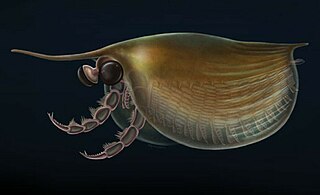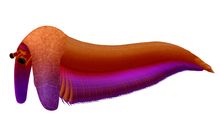
Yohoia is an extinct genus of megacheiran arthropod from the Cambrian period that has been found as fossils in the Burgess Shale formation of British Columbia, Canada. The type species, Yohoia tenuis, was described in 1912 by Walcott, who considered it an anostracan crustacean. 711 specimens of Yohoia are known from the Greater Phyllopod bed, where they comprise 1.35% of the community. In 2015, Conway Morris et al. reported another species, Y. utahana, from the Marjum Formation, Utah.

Canadaspis is an extinct genus of bivalved Cambrian arthropod, known from North America and China. They are thought to have been benthic feeders that moved mainly by walking and possibly used its biramous appendages to stir mud in search of food. They have been placed within the Hymenocarina, which includes other bivalved Cambrian arthropods.

Waptia is an extinct genus of arthropod from the Middle Cambrian of North America. It grew to a length of 6.65 cm (3 in), and had a large bivalved carapace and a segmented body terminating into a pair of tail flaps. It was an active swimmer and likely a predator of soft-bodied prey. It is also one of the oldest animals with direct evidence of brood care. Waptia fieldensis is the only species classified under the genus Waptia, and is known from the Burgess Shale Lagerstätte of British Columbia, Canada. Specimens of Waptia are also known from the Spence Shale of Utah, United States.

Odaraia is a genus of bivalved arthropod from the Middle Cambrian. Its fossils, which reach 15 centimetres (5.9 in) in length, have been found in the Burgess Shale in British Columbia, Canada.

Megacheira is an extinct class of predatory arthropods defined by their possession of spined "great appendages". Their taxonomic position is controversial, with studies either considering them stem-group euarthropods, or stem-group chelicerates. The homology of the great appendages to the cephalic appendages of other arthropods is also controversial. Uncontested members of the group were present in marine environments worldwide from the lower to middle Cambrian.

Plenocaris plena is a Cambrian arthropod with a bivalved carapace, and is known from the Burgess shale and Chengjiang. Originally described as a species of Yohoia by Walcott in 1912, it was placed into its own genus in 1974.

Clypecaris is genus of bivalved Cambrian arthropod known from the Chengjiang biota of Yunnan, China. The genus was initially described for the type species C. pteroidea by Hou, 1999. A second species C. serrata was described by Yang et al. in 2016. The species are primarily distinguished by the presence of a serrated edge on the front of the carapace of C. serrata. C. serrata is noted for the modification of an anterior pair of limbs into spined grasping appendages, indicating a predatory lifestyle. It is unknown whether a similar structure was present in C. pteroidea.Clypecaris is considered to likely be a member or a close relative of Hymenocarina, and is closely related to Perspicaris. As well as to Ercaicunia.

Ercaicunia is genus of bivalved Cambrian arthropod from the Chengjiang biota of Yunnan, China. It contains a single species, E. multinodosa that was described by Luo et al. in 1999. The total length of the body ranges from 8 to 11 millimetres. The bivalved carapace covered about a third of the total body-length, and has up to six serrations on its forward edge. The head has a pair of large uniramous antennae, as well as a smaller pair of secondary antennae, as well as pair of mandibles and maxillae. The trunk has 16 pairs of biramous appendages. Specimens were CT scanned in 2019, which suggested it to be a stem-group crustacean. Other subsequent studies have recovered it as a member of Hymenocarina, which contains other bivalved Cambrian arthropods.

Haikoucaris is a genus of megacheiran arthropod that contains the single species Haikoucaris ercaiensis. It was discovered in the Cambrian Chengjiang biota of China.

Pectocaris is an extinct genus of bivalved arthropods from the Cambrian Maotianshan Shales, Yunnan Province of China. There are currently three known species within the genus.

Radiodonta is an extinct order of stem-group arthropods that was successful worldwide during the Cambrian period. They may be referred to as radiodonts, radiodontans, radiodontids, anomalocarids, or anomalocaridids, although the last two originally refer to the family Anomalocarididae, which previously included all species of this order but is now restricted to only a few species. Radiodonts are distinguished by their distinctive frontal appendages, which are morphologically diverse and used for a variety of functions. Radiodonts included the earliest large predators known, but they also included sediment sifters and filter feeders. Some of the most famous species of radiodonts are the Cambrian taxa Anomalocaris canadensis, Hurdia victoria, Peytoia nathorsti, Titanokorys gainessii, Cambroraster falcatus and Amplectobelua symbrachiata, the Ordovician Aegirocassis benmoulai and the Devonian Schinderhannes bartelsi.

Hurdia is an extinct genus of hurdiid radiodont that lived 505 million years ago during the Cambrian Period. Fossils have been found in North America, China and the Czech Republic.

Marble Canyon is a canyon surrounding Tokumm Creek just above its confluence with the Vermilion River, at the north end of Kootenay National Park in the Canadian Rockies of British Columbia, Canada. South of Marble Canyon on Highway 93 is Numa Falls on the Vermillion River.

Cucumericrus ("cucumber-leg") is an extinct genus of stem-arthropod. The type and only species is Cucumericrus decoratus, with fossils discovered from the Maotianshan Shales of Yunnan, China.

Tokummia is a genus of fossil hymenocarine arthropod, known only by one species, Tokummiakatalepsis, from the middle Cambrian Burgess Shale as found in a quarry in Marble Canyon in Canada.

Hymenocarina is an order of extinct arthropods known from the Cambrian. They possess bivalved carapaces, typically with exposed posteriors. Members of the group are morphologically diverse and had a variety of ecologies, including as filter feeders and as predators. Recent research has generally considered them to be stem or crown group members of Mandibulata, due to the presence of mandibles in some species.

Titanokorys is a genus of extinct hurdiid radiodont that existed during the mid Cambrian. It is the largest member of its family from the Cambrian, with a body length of 50 cm (20 in) long, making it one of the largest animals of the time. It bears a resemblance to the related genus Cambroraster. Fossils of T. gainesi were first found within Marble Canyon in 2018. The fossils were not named until 2021 because they were assumed to be giant specimens of Cambroraster.

Fibulacaris is a monotypic genus of fossil arthropod known only by one species, Fibulacaris nereidis, discovered from the Cambrian Burgess Shale of Canada. It was characterized by a bivalved carapace with an inverted rostrum, sandwiching the slender body with stalked eyes and homonomous appendages. It was probably an actively swimming filter feeder and possibly swam upside-down like some branchiopod crustaceans and horseshoe crabs. Phylogenetic analysis suggest it was a relative or member of Hymenocarina, which contains other bivalved arthropods.

Isoxyids are members of the order Isoxyida and the family Isoxyidae, a group of basal arthropods that existed during the Cambrian period. It contains two genera, Isoxys, with 20 species found worldwide, and Surusicaris known from a single species found in the Burgess Shale of Canada. They are distinguished by their bivalved carapaces and pair of upward curving grasping frontal appendages.

Cordaticaris is a genus of extinct hurdiid radiodont that lived in what is now northern China during the middle Cambrian period. This animal was described in 2020 based off remains found in the Zhangxia Formation, located in the Shandong Province. It is differentiated from other members of its family by its unique heart-shaped frontal sclerite, and its frontal appendages bearing nine endites and seven more elongated subequal endites. This animal was important as it was the first Miaolingian aged hurdiid known from rock layers outside of laurentia, allowing paleontologists to get a better grasp of this families geographic range in life.





















